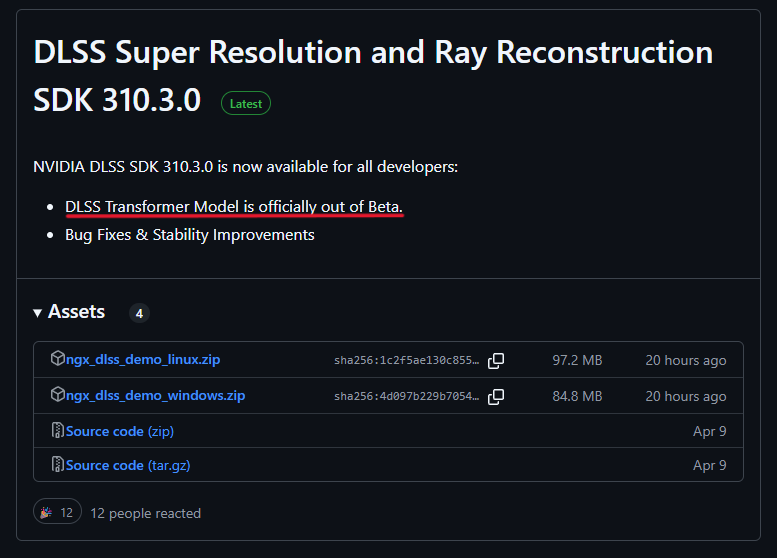DLSS Transformer Model for DLSS 4 is out of beta as Nvidia looks to officially incorporate new model to improve image quality and efficiency

Nvidia announced the next generation of DLSS back at CES 2025, adding to the already-impressive repertoire of industry support carried forward by previous DLSS versions. There's no question that, even with AMD starting to catch up with FSR 4, Nvidia's DLSS is the premier upscaling technology for gamers. Nvidia has made a massive leap with DLSS 4, which is now out of beta with its latest release.

CNN vs. Transformers
Up until now, DLSS was constrained to using CNNs, or Convolutional Neural Networks. CNNs work by analyzing neighboring pixels and estimating their worth in each frame. This allows for the quick generation of artificial pixels that upscale the image, but it can often result in artifacts based on incorrect predictions. Despite improvements in this area, CNNs eventually started to show their age, and it was clear that not much more could be achieved by sticking with the same method.
Therefore, Nvidia switched to a Transformer-based model for DLSS 4, shaking up things in a big way. Under the hood, the model examines every pixel in a frame to analyze its importance, rather than relying on rough estimates from large pixel clusters, as in CNNs. This enables finer detail that would otherwise be lost or obfuscated with imprecise pixels from a surrounding area. In the end, you get a much sharper image that looks closer to native resolution than ever before.

Apart from the boost in visuals, the Transformer model also brings a significant improvement in efficiency. Nvidia has doubled the parameters of DLSS 4 compared to previous models, which enables a 30-50% increment in raytracing performance all while having reduced latency from 3.25ms to just 1ms on an RTX 5090.
If you have an RTX 50-series GPU, DLSS 4 heavily benefits from the Blackwell architecture and enables multi-frame generation. Instead of 1 fake frame being generated between 2 real ones, it can generate up to 3 fake frames from just 1 preceding real frame. Not only that but thanks to memory optimizations and vertical layer fusion, RTX 50-series can easily handle Transformer models twice the size of their CNN counterparts without breaking a sweat.

All that being said, the Transformer model is coming to all RTX GPUs regardless of their generation. So even if you're rocking a Turing card, you'll still get to enjoy all the advances made with Transformer-based DLSS (apart from frame gen). Expect smoother gameplay with less jagged edges, less ghosting during motion, and reduction in overall artifacting due to a more nuanced understanding of the scene.
Today, DLSS's Transformer model exits beta in the newly released 310.3.0 update. Nvidia should be officially switching to the Transformer model and phasing out CNNs for the stable DLSS release in the following months. We can't wait to see how DLSS 4 helps deliver more stable pixels in our favorite games.
Get Tom's Hardware's best news and in-depth reviews, straight to your inbox.

Hassam Nasir is a die-hard hardware enthusiast with years of experience as a tech editor and writer, focusing on detailed CPU comparisons and general hardware news. When he’s not working, you’ll find him bending tubes for his ever-evolving custom water-loop gaming rig or benchmarking the latest CPUs and GPUs just for fun.
-
TechyInAZ I still get a performance boost from using CNN over the Transformer model. Hopefully we'll still be able to manually swap between models in games. Or Nvidia rectifies the performance impact of the Transformer model on older GPUs.Reply -
NightKnight1337 Reply
imo that's irrelevant over the much better resulting image it produces. You're still getting a performance increase over native, isn't that all that matters?TechyInAZ said:I still get a performance boost from using CNN over the Transformer model. Hopefully we'll still be able to manually swap between models in games. Or Nvidia rectifies the performance impact of the Transformer model on older GPUs.
Better quality and better performance than Native -
KevinS1010 Reply
Not when you are already using DLSS CNN Performance to get good performance.NightKnight1337 said:imo that's irrelevant over the much better resulting image it produces. You're still getting a performance increase over native, isn't that all that matters?
Better quality and better performance than Native
On my RTX 2060 laptop, the Transformer model is simply not worth it. I'm going down from 87 FPS to 69 FPS in Cyberpunk. With the TM model I can no longer hold a stable 60 FPS. So this argument only applies to people who have higher end hardware and who currently run DLSS Quality upscaling. -
TechyInAZ Exactly this ^^^. Additionally the CNN model already looks good, specifically at 4K resolution. When upscaling from 1080p, it is a perfect 2:1 upscale so DLSS works even better than usual especially in motion. (Actually i find no reason to used balanced or quality mode at 4k, because the 2:1 up-scaling ratio punches above its weight.)Reply -
hotaru251 Reply
nvidia doesnt care about older models.TechyInAZ said:Or Nvidia rectifies the performance impact of the Transformer model on older GPU
they want you to buy more product. -
Imaletyoufinish Reply
4K is 4 times the pixels of 1080p so it would be a 4:1 upscale not 2:1. Where did you get the 2:1 number from?TechyInAZ said:Exactly this ^^^. Additionally the CNN model already looks good, specifically at 4K resolution. When upscaling from 1080p, it is a perfect 2:1 upscale so DLSS works even better than usual especially in motion. (Actually i find no reason to used balanced or quality mode at 4k, because the 2:1 up-scaling ratio punches above its weight.)